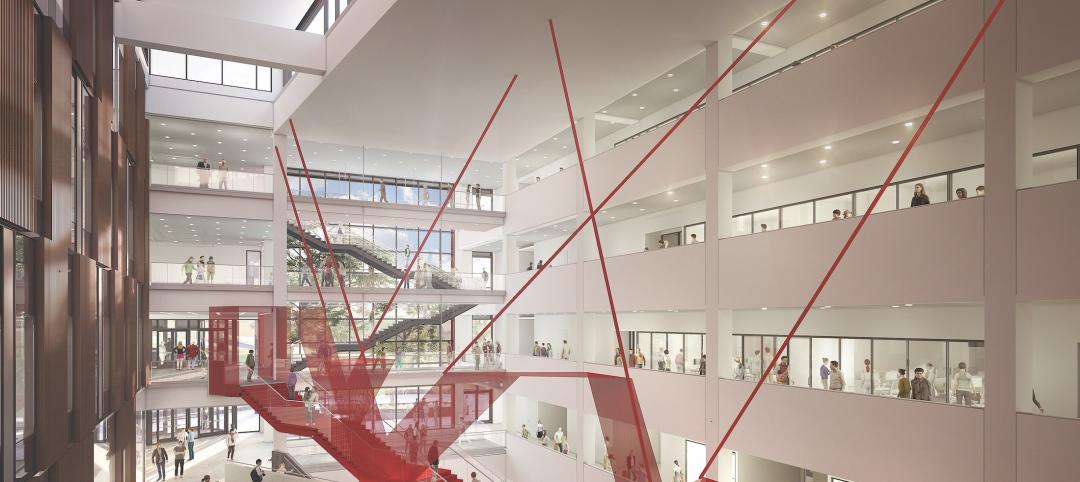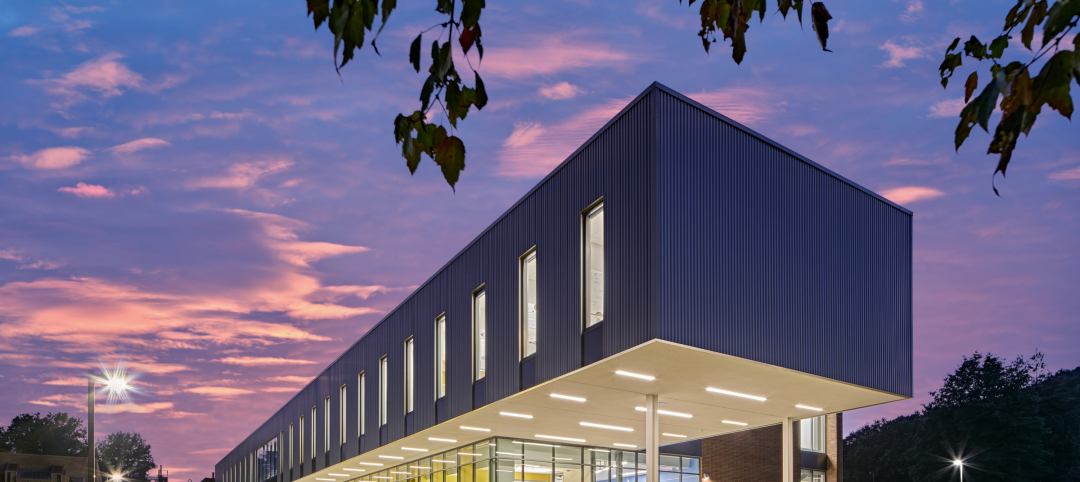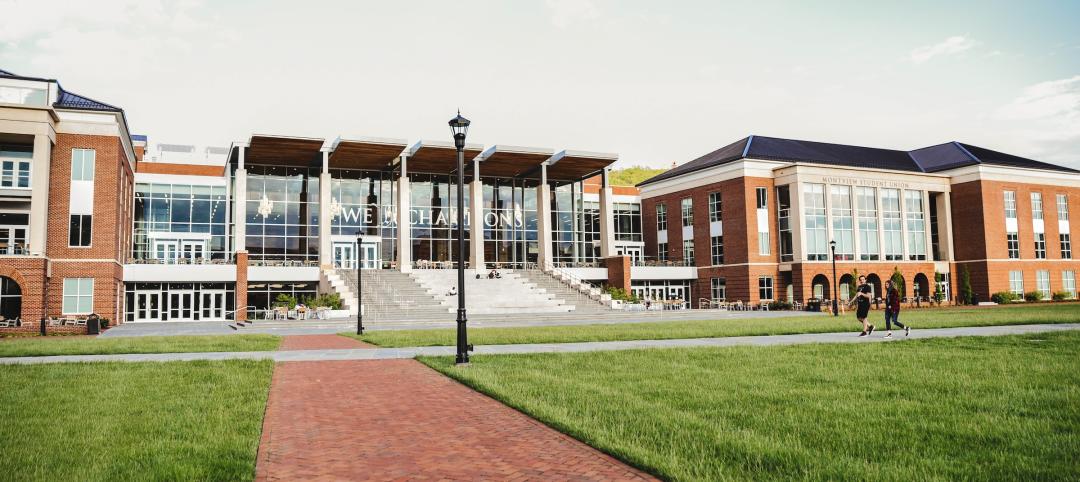Will online learning become a staple for America’s colleges and universities, even after the coronavirus subsides? And if it does, what will that mean for existing and future buildings on campuses across the country?
These have become a fundamental—even existential—questions that AEC firms say their higher ed clients are pondering. While online learning isn’t expected to replace classroom learning over the long run, some firms already see a movement brewing that favors a hybrid model offering collegians both options.
“Colleges and universities are taking immediate steps to de-densify classrooms and residence halls, forcing many institutions to adopt a hybrid pedagogical model whereby approximately one-third of students will receive in-person instruction concurrent with online instruction,” says Patrick McCafferty, Principal and Education Business Leader at Arup’s Boston office. Arup is already sensing diminishing demand for large lecture halls. (McCafferty wonders, though, if a hybrid model might inadvertently create a tiered student experience.)
Chris Purdy, AIA, LEED AP, Vice President and Higher Education Practice Director for SmithGroup, anticipates a “widespread acceptance” of the hybrid learning format. He adds that campus de-densification will require rapid, data-driven strategic planning. Erin Joseph Machau, Jacobs’ Higher Education Market Leader, sees these trends inevitably leading toward more modular and flexible design.
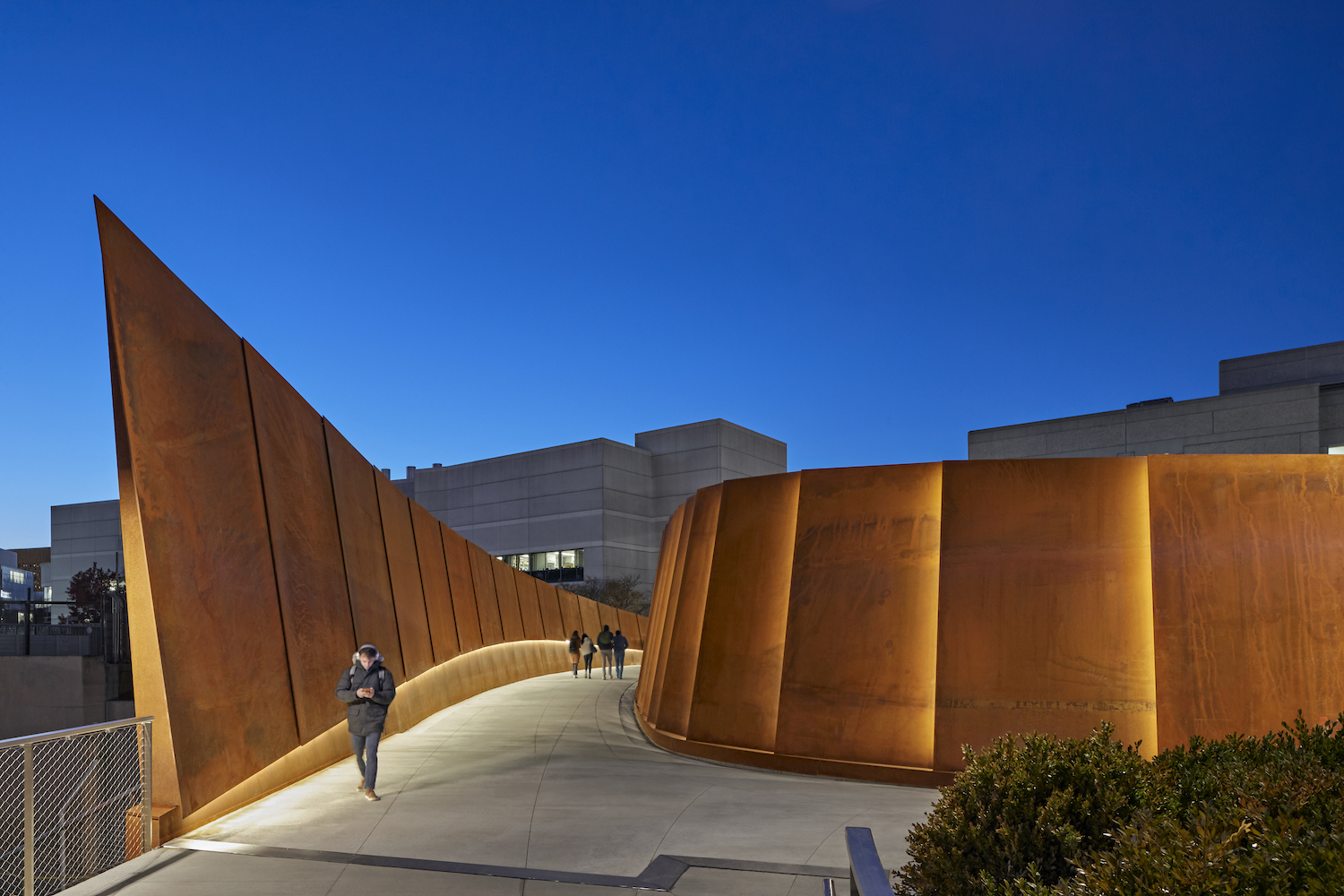
Northeastern University Interdisciplinary Science and Engineering complex. Photo: Tanguy Marquis
“Higher Education will rebound, but the type of projects needed will change,” predicts Machau. “Campus and departmental master planning, facility condition assessments, building and space inventory, and other consulting services will likely increase in need,” as universities lick their wounds from revenue losses, and reboot their space needs in light of what the “campus experience” and “student living” actually mean these days.
“COVID-19 has opened the door for campuses to make big changes for themselves and for their students,” says Tracy De Leuw, DPR Construction’s Higher Ed Core Market Leader. He, too, thinks more schools will focus on hybrid solutions that include combining multiple disciplines—such as business and finance with computer engineering and science—into mini think tanks.
Hybrid learning—such as the HyFlex course design model that gives students the option of attending classes online or physically—depends on technology. Schools are already leveraging technology to offset the impact of social distancing, says Damon Sheppard, HOK’s Regional Leader of Science + Technology. The shift toward learning from home could also spur greater demand for data centers and infrastructure investments, suggests Paul Erb, Executive Vice President for McCarthy Building Companies.
P3s could shore up shortfalls in the university sector
The embrace of hybrid learning, be it tentative or gung-ho, comes at a time when universities are staring at some stark economic realities. The higher education sector is girding for at least a 10% revenue reduction this year as a result of the coronavirus. The suspension of classes and the evacuation of student housing were major hits to many schools’ revenue streams. And going forward, will schools be able to justify what they charge for tuition if courses are delivered online?
The virus “created an unsustainable business model and operating budget gaps,” says Sean Edwards, Suffolk Construction’s COO for Higher Education. That led to pauses in new construction of many capital projects, and slowdowns in the planning and design of projects that weren’t already underway. Erb of McCarthy elaborates that while most of his firm’s higher ed projects already in design are moving forward, future projects have been “pushed out” farther.
Even PCL Construction, which as of mid-June had 23 higher ed projects under construction, expects universities to experience revenue losses from social distancing requirements and the downsizing of dorms, which could force more students into off-campus housing, says Bob Hopfenberg, the firm’s Vice President of National Business Development. PCL predicts more separation within classrooms, and modifications to dorms and residence halls that reduce student occupancies.
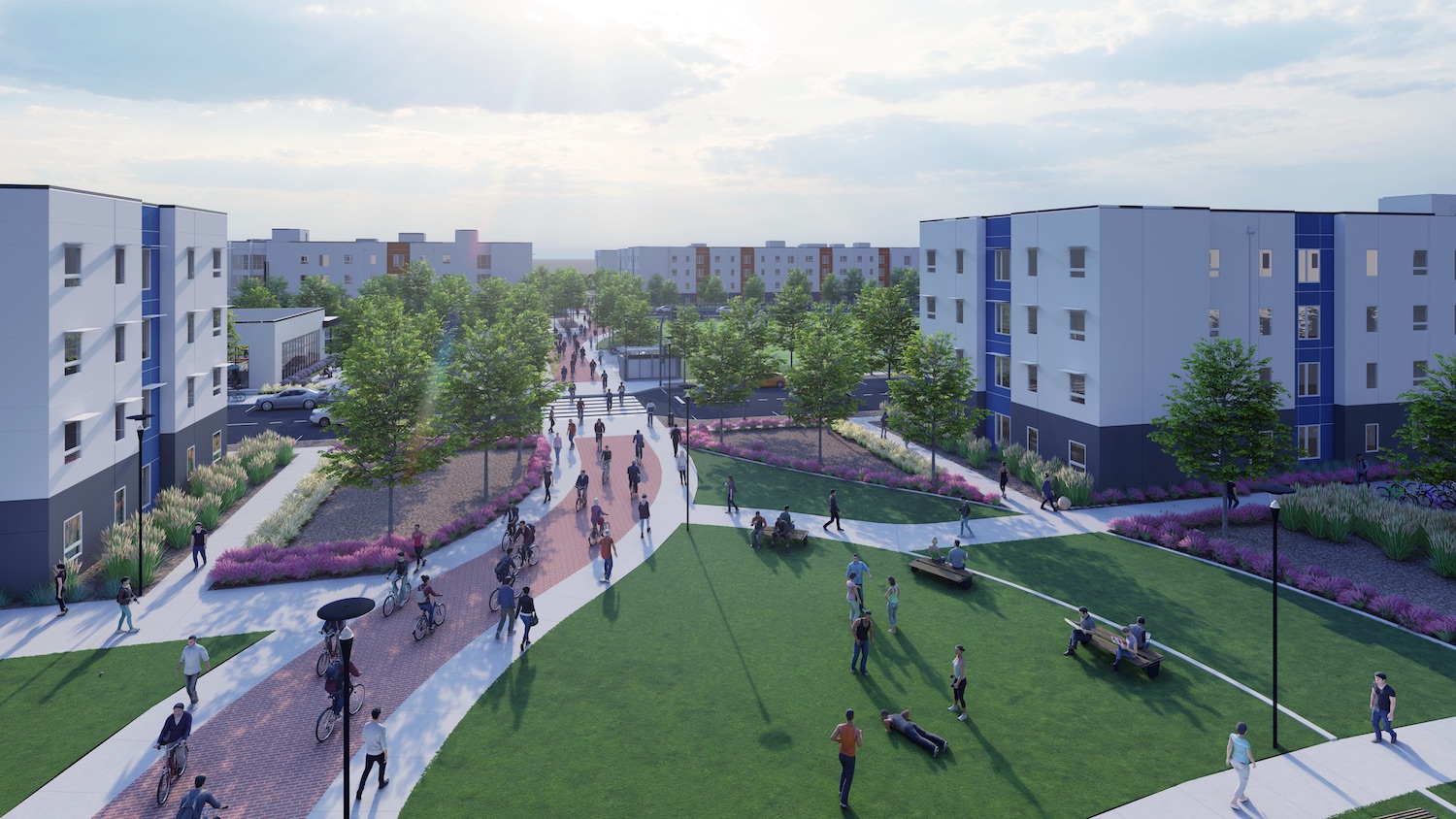
Under construction on the campus of the University of California at Davis is the nation’s largest public-private partnership for a student housing project in the U.S. Stantec, The Michaels Organization, and CGB Building Company are part of the team for this complex, which will have 1,875 student beds within nine four-story apartment buildings. Rendering: Stantec
Several AEC firms say their university clients are turning more aggressively to public-private partnerships (P3s) to finance future campus renovation and construction. One of Stantec’s higher ed jobs under construction is at the University of California–Davis: the nation’s largest P3 student housing project to date.
“If universities can’t keep up with demand, they can turn to the private sector for facilities to accommodate student housing and dining,” observes Brent Amos, Principal and Secretary-Treasurer for Cooper Carry. Arup’s McCafferty thinks there will be renewed interest in funding initiatives and investment streams associated with biological sciences and medical research.
The economic turmoil caused by the coronavirus will also thin the herd. Suffolk’s Edwards foresees some smaller institutions merging or being acquired by larger universities. Such consolidations could create opportunities for mixed-use developments that have synergies with universities, such as research labs or commercial space. Other private institutions that don’t choose the P3 or consolidation route might seek to monetize their land assets to generate capital for future construction.
Reassessing space needs in college buildings
The pandemic gave colleges and universities a pressing reason to reevaluate their assets, in order to figure out how they fit into longer-term sustainability plans. For example, about 30% of a typical campus footprint is currently used for administrative and faculty space, notes Patricia Bou, AIA, CannonDesign’s Co-Director–Education Market. Her colleague Charles Smith, AIA, believes that S+T and research facilities could gain importance as part of cross-disciplinary education. “The same goes for healthcare and medical education,” says Smith. “We’re thinking about how to address the intersection of health, science, and data.”
They also suggest that academic institutions should think about alternative uses for dining facilities and recreation centers if their on-campus populations are going to get smaller.
Priorities might change relative to building needs, with a shift in focus toward more adaptation of existing buildings or enhancement of building systems, say Summer Heck, Marketing and BD Manager-Education and S+T at Stantec’s office in Raleigh-Durham, N.C.; and Stephen Phillips, a Vice President at the firm’s Toronto office. “The pandemic will reinforce the rise of renovation and adaptive reuse projects, a trend we’ve been seeing in recent years,” concurs Cooper Carry’s Amos.

Emory University’s Health Research Science Building 2 is scheduled to open in Atlanta in 2022. HOK’s design supports Emory’s campus-wide sustainability efforts and aggressive goals for energy use reduction. Rendering: HOK
Stantec’s executives are seeing a continued focus on career and technical education and skills development. And innovation centers “are at the forefront on institutions’ minds,” they say.
Design professionals like HOK’s Sheppard are now being asked to consider academia’s long-term space strategies, and not just the short-term physical impacts of COVID-19. To that end, Sheppard sees HOK’s role evolving to help clients define how campus space supports their schools’ core missions, determine how much physical space is needed by typology, and assess the value of that space via post-occupancy evaluations.
Suffolk, says Edwards, has moved toward design-assist delivery and virtual design and construction tools to reinforce its expertise to university clients for space planning, building systems, operations, and maintenance.
SmithGroup’s Purdy says his firm is seeing “some exciting opportunities,” including major projects budgeted at $200 million or more, through the firm’s Scenario Mapping projects and CampusForward research. “We are going beyond sustainability and acute shocks, such as earthquakes and floods, to address future disease outbreaks and the chronic stresses of justice and equity.” The goal, he says, is to re-establish the “value” of the on-campus experience.
Related Stories
University Buildings | Jan 15, 2024
The death of single-use university buildings
As institutions aim to improve the lives of their students and the spaces they inhabit, flexible university buildings may provide an all-in-one solution.
University Buildings | Dec 8, 2023
Yale University breaks ground on nation's largest Living Building student housing complex
A groundbreaking on Oct. 11 kicked off a project aiming to construct the largest Living Building Challenge-certified residence on a university campus. The Living Village, a 45,000 sf home for Yale University Divinity School graduate students, “will make an ecological statement about the need to build in harmony with the natural world while training students to become ‘apostles of the environment’,” according to Bruner/Cott, which is leading the design team that includes Höweler + Yoon Architecture and Andropogon Associates.
University Buildings | Dec 5, 2023
The University of Cincinnati builds its largest classroom building to serve its largest college
The University of Cincinnati’s recently completed Clifton Court Hall unifies the school’s social science programs into a multidisciplinary research and education facility. The 185,400-sf structure is the university’s largest classroom building, serving its largest college, the College of Arts and Sciences.
Products and Materials | Nov 30, 2023
Top building products for November 2023
BD+C Editors break down 15 of the top building products this month, from horizontal sliding windows to discreet indoor air infusers.
Higher Education | Nov 21, 2023
UPitt at Bradford opens new Engineering & Information Technologies Building
The University of Pittsburgh at Bradford recently opened a new engineering and information technology building that adds urgently needed lab and instructional space to the campus.
Esports Arenas | Oct 10, 2023
Modular esports arena attracts more than gamers
As the esports market continues to grow to unprecedented numbers, more facilities are being developed by universities and real estate firms each year.
Higher Education | Oct 10, 2023
Tracking the carbon footprint of higher education campuses in the era of online learning
With more effective use of their facilities, streamlining of administration, and thoughtful adoption of high-quality online learning, colleges and universities can raise enrollment by at least 30%, reducing their carbon footprint per student by 11% and lowering their cost per student by 15% with the same level of instruction and better student support.
Giants 400 | Sep 28, 2023
Top 80 University Building Engineering Firms for 2023
AECOM, Jacobs, BR+A, and Salas O'Brien head BD+C's ranking of the nation's largest university sector engineering and engineering/architecture (EA) firms for 2023, as reported in Building Design+Construction's 2023 Giants 400 Report. Note: This ranking includes revenue for all university/college-related buildings except student residence halls, sports/recreation facilities, laboratories, S+T-related buildings, parking facilities, and performing arts centers (revenue for those buildings are reported in their respective Giants 400 ranking).
Giants 400 | Sep 28, 2023
Top 100 University Building Construction Firms for 2023
Turner Construction, Whiting-Turner Contracting Co., STO Building Group, Suffolk Construction, and Skanska USA top BD+C's ranking of the nation's largest university sector contractors and construction management firms for 2023, as reported in Building Design+Construction's 2023 Giants 400 Report. Note: This ranking includes revenue for all university/college-related buildings except student residence halls, sports/recreation facilities, laboratories, S+T-related buildings, parking facilities, and performing arts centers (revenue for those buildings are reported in their respective Giants 400 ranking).
University Buildings | Sep 27, 2023
Top 170 University Building Architecture Firms for 2023
Gensler, CannonDesign, Page Southerland Page, SmithGroup, and Ayers Saint Gross top the ranking of the nation's largest university sector architecture and architecture/engineering (AE) firms, as reported in Building Design+Construction's 2023 Giants 400 Report.



